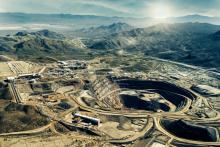ASX-listed Eclipse Metals has vectored in on a large circular magnetic anomaly containing multiple conductive exploration targets on its ground just a kilometre or two east of its recently acquired Ivittuut cryolite mine in southern Greenland. Eclipse is targeting cryolite, rare earth elements, high-purity silica and even nickel sulphides as it continues to explore its tenement in the frozen north.


ASX-listed Eclipse Metals has vectored in on a large magnetic anomaly containing multiple conductive exploration targets on its ground just a kilometre or two east of its recently acquired Ivittuut cryolite mine in southern Greenland. Eclipse is targeting cryolite, rare earth elements, high-purity silica and even nickel sulphides as it continues to explore its tenement package containing the old mine.
The company said the geophysical anomaly was a large circular feature, perhaps representing a granitic intrusive body and its Ivittuut mine appears to be perched on the edge of the anomaly.
Two smaller ovoid bodies associated with carbonatite bodies have been mapped and both appear to be larger than previously thought, adding to the potential for significant deposits of carbonatite, rare earths and sulphides.
Interestingly, the fresh geophysical interpretation has thrown up numerous gabbroic dykes and sills that criss-cross the magnetic anomaly. According to Eclipse, gabbroic dykes are known to host nickel sulphides, as seen in historic drill holes some 30km to the south.
Eclipse said the reprocessing of the clutch of historical magnetic and electromagnetic data sets has identified seven conductive targets across its ground. All are untested anomalies and all are likely to be followed up with future exploration and drilling activities.
The company says the ground east of Gronnedal in south-western Greenland has the potential to host rare earths, magnetite and massive sulphide minerals.
With the fresh exploration targets sitting just east of its Ivittuut mine infrastructure, early extraction possibilities will likely become an option if near-term exploration drilling is successful.
Ivittuut remains the only commercial, naturally occurring deposit of cryolite in the world and has a long history of mining. The deposit was exploited for over a century before closing in 1987 when resources of the high-grade cryolite ores dwindled.
According to Eclipse, low-grade cryolite stockpiles remain at surface and two additional accumulations of the mineral are known to exist at depth, below the base of the Ivittuut mine’s existing open pit.
Cryolite is a specialty mineral that is used as a “fluxing agent” in the production of aluminium, greatly reducing energy consumption through the smelting process, however the deposit also contains a potential treasure trove of accessory minerals including zinc, fluorite, rare earths and high-purity silica, underlying the immense mineral potential of Greenland.
Eclipse Metals Executive Chairman, Carl Popal said recently the Greenland acquisition had the potential to supply specialist minerals to the world’s burgeoning green energy industry.
Eclipse also believes the country’s only known carbonatite deposit could become an ideal product for neutralising acid mine and process water produced by other miners in the Greenlandic region.
The Ivittuut project is located in south-west Greenland, a region renowned for its rich endowment in specialty metals which include rare earth elements, tantalum, niobium, uranium and zirconium.
Ivittuut boasts outstanding infrastructure, with its namesake town, adjacent to the mine, hosting a power station, wharf and fuel supplies to support mining and exploration activities. Elsewhere, the town of Gronnedal is only 5km to the north, complete with a heliport and its own port facility.
Eclipse now has a big X on its maps marking a location that may well be harbouring some overlooked treasures.
Only time will tell.
Is your ASX-listed company doing something interesting? Contact: matt.birney@businessnews.com.au











